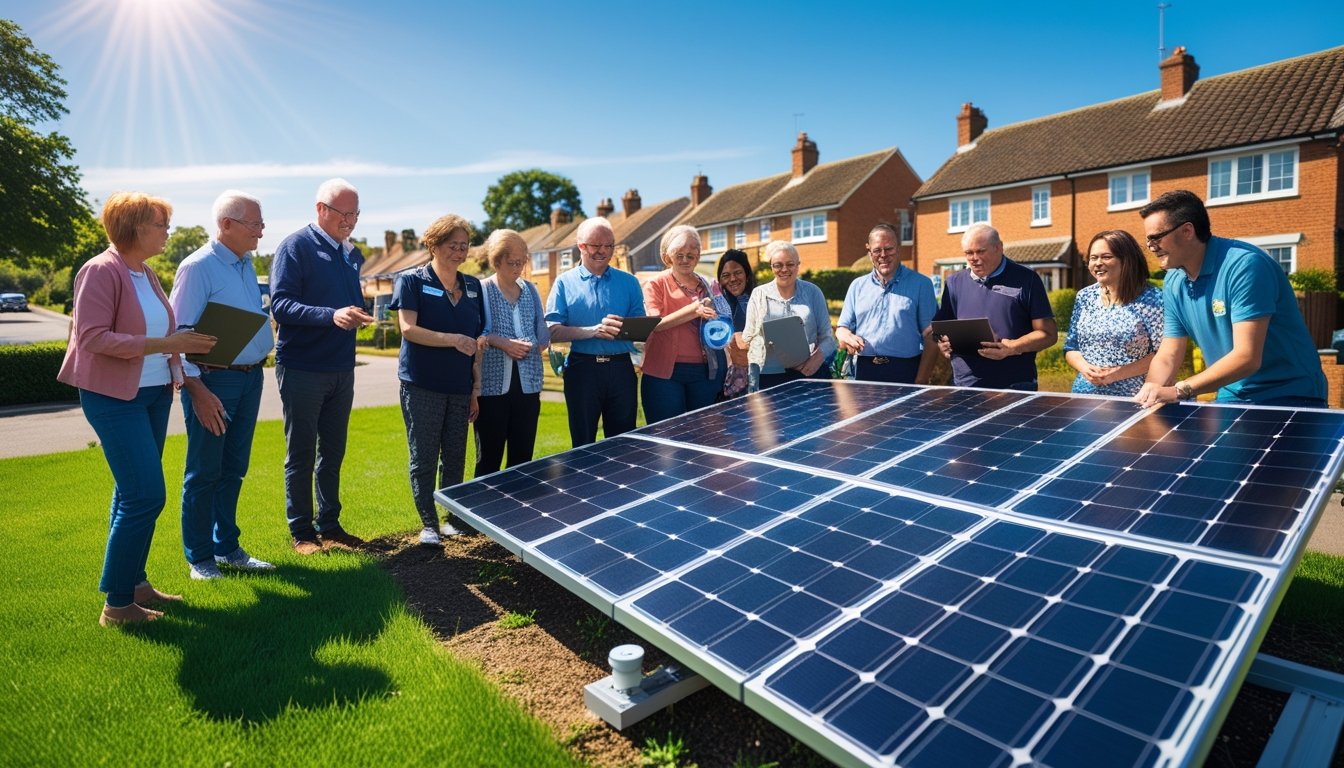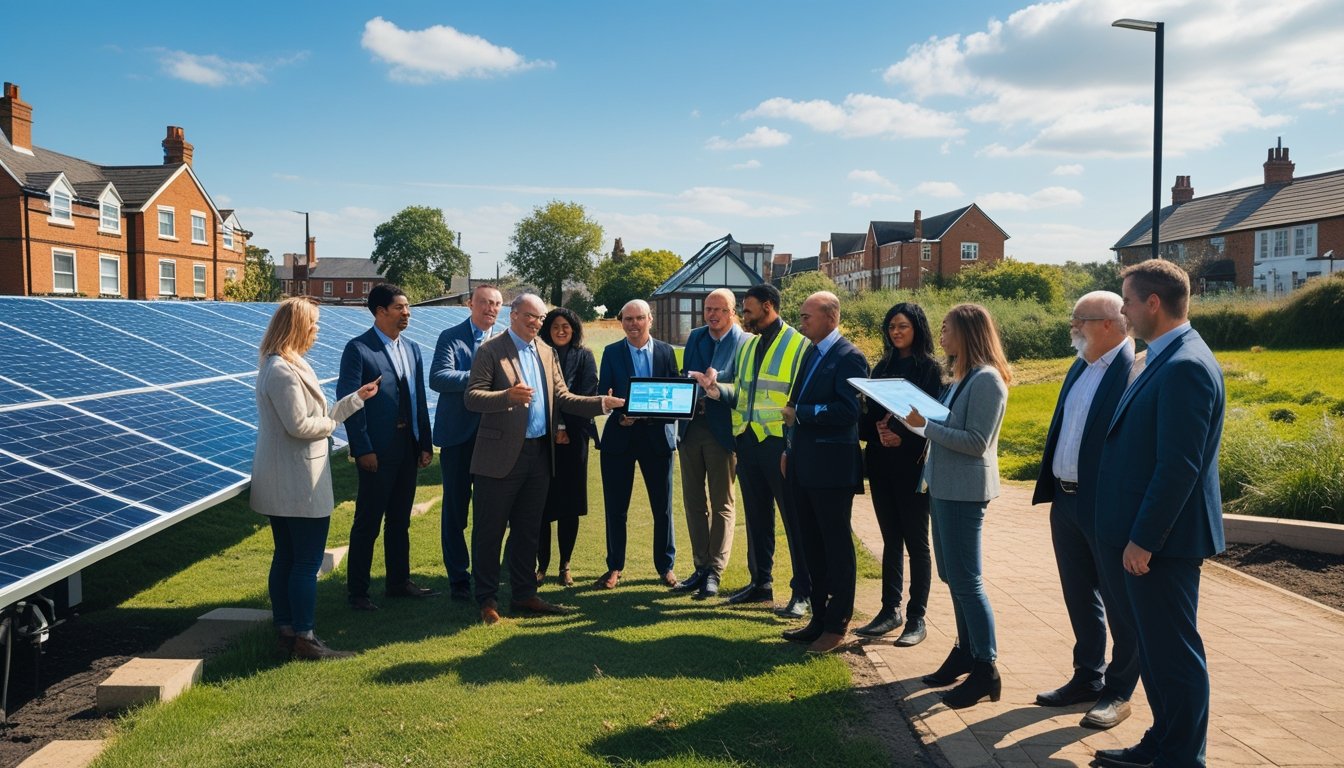Late updated: 11 Jul 2025 15:07
Written by: Eleanor Hartman
Harnessing Local Community Solar Initiatives in the UK: Empowering Sustainable Energy
In the UK, community solar initiatives are gaining significant traction as local groups come together to tap into sustainable energy solutions. These projects empower communities to take control of their energy use and promote environmental sustainability, while simultaneously cutting costs and fostering economic growth. By pooling resources and harnessing the sun's power, communities across the country are not only reducing their carbon footprint but also attaining energy independence.

With a growing emphasis on transitioning towards renewable energy, the UK is witnessing a dynamic resurgence of community solar projects. These initiatives are vital in our collective journey towards a net-zero economy, creating opportunities for local engagement and resilience. By involving residents in the decision-making and management processes, these solar projects ensure that the benefits are shared widely, strengthening the social fabric and economic self-sufficiency.
Despite the clear advantages, community solar initiatives do face challenges such as funding and regulatory hurdles. Yet, the determination and collaboration within these communities demonstrate a path to overcome these barriers, showcasing a model of success that could inspire further adoption across the nation.
Key Takeaways
- Community solar projects offer environmental and economic benefits.
- Local involvement strengthens community resilience and engagement.
- Challenges exist but are met with collaborative determination.
Key Aspects of Local Community Solar Initiatives in the UK
Community solar projects in the UK harness local resources to generate renewable energy. These initiatives involve various stakeholders, including local authorities and community groups. Understanding how these projects operate is essential for proper implementation and sustainability. Key elements of these projects include operational models, involvement of local entities, diverse installation types, and innovative business frameworks.
How Community Solar Projects Operate
Community solar projects work by allowing multiple participants to share the benefits of a single solar array. This typically involves a collaborative approach, where residents invest in and co-own solar installations. The electricity generated is fed into the grid, crediting participants with energy savings.
The operation requires careful planning and coordination among participants. Typically, a community energy group develops the plan, often in partnership with local councils or third-party entities. Efficient management ensures that generated solar energy is equitably distributed, reducing reliance on traditional power sources and ultimately lowering emissions.
Role of Local Authorities and Community Groups
Local authorities play a vital role in the development and success of community solar initiatives. They provide regulatory support, facilitate land access, and sometimes offer funding. Such involvement ensures that projects meet legal requirements and align with community goals.
Community groups are equally important. These groups engage residents, build awareness, and foster collaboration among stakeholders. By mobilising local resources and expertise, community groups can help drive project success, ensuring both environmental and economic benefits are realised.
Types of Community Solar Installations
Community solar installations vary widely, adapting to different community needs and geographical constraints. Rooftop solar panels are common for urban areas, utilising existing infrastructure. Ground-mounted installations are suitable for rural locations where land is available, offering more extensive solar arrays.
Additionally, some projects combine solar with other renewable sources like wind or hydroelectricity to enhance energy generation. Tailoring the type of installation to suit local conditions helps in maximising efficiency and community engagement.
Power Purchase Agreements and Business Models
Power Purchase Agreements (PPAs) are crucial for community solar projects. PPAs provide a structured way to sell generated electricity back to the grid or directly to consumers. They ensure a steady income stream, supporting the project's financial viability.
Diverse business models can be employed, ranging from cooperative ownership to partnership with commercial developers. Each model offers different benefits. Co-ops might focus more on local reinvestment, while partnerships can provide additional resources and expertise. Varied financing methods and revenue models enable more communities to participate and benefit from solar energy.
Benefits, Challenges, and Future of Community Solar in the UK

Community solar initiatives in the UK are reshaping how we access clean energy. They bring economic gains and environmental improvements, while also providing wider opportunities for participation. There are still challenges to overcome, but with advancing technology and supportive policies, the future looks promising.
Environmental and Economic Benefits
Community solar projects significantly reduce our carbon footprint, promoting environmental sustainability. By utilising locally generated renewable energy, we lessen the need for fossil fuels, contributing to climate change mitigation. Economically, these projects generate local employment. Solar panel installation and ongoing maintenance create jobs, stimulating local economies and supporting the government’s net zero plans.
Moreover, by investing in such green energy initiatives, communities collectively save on energy costs. Access to affordable electricity through shared ownership encourages energy independence. The implementation of large-scale solar farms also supports the energy efficiency goals for a sustainable future.
Inclusion of Homeowners and Renters
One significant advantage of community solar is its inclusivity. Unlike traditional solar energy systems that often require ownership of property, these initiatives allow both homeowners and renters to participate. This form of energy generation ensures that everyone, regardless of property ownership, can benefit from clean energy.
By providing access without the need for individual infrastructure investments, it democratizes renewable energy projects. Community members purchase shares in a solar farm, receiving credits towards their electricity bills. This model of shared benefits fosters greater engagement and commitment towards sustainable energy solutions.
Barriers and Technological Innovations
Despite the numerous benefits, community solar faces certain barriers. Financing remains a crucial challenge, with projects needing substantial initial investment. Regulatory frameworks can also be complex, leading to delays. Moreover, the lack of widespread public awareness impedes participation.
However, ongoing technological innovations offer hope. Advances in solar technology reduce costs and increase efficiency, making projects more viable. The integration of energy storage solutions like batteries further complements the intermittent nature of solar energy, allowing us to optimise generation and use. These developments, coupled with community engagement strategies, are critical for overcoming existing hurdles.
Future Prospects and Policy Support
Looking forward, the potential for community solar in the UK is immense. Policy support plays a vital role in nurturing this growth. The UK Solar Roadmap 2025 outlines strategies to expand deployment, while initiatives like the Community Benefits Protocol aim to facilitate discussions between solar companies and local communities.
To ensure a flourishing future, ongoing government incentives and community partnerships are essential. Investment in large-scale renewable projects and wind turbines further diversifies our energy portfolio, driving progress not just for solar but for all renewables. With continued commitment, community solar is set to become a cornerstone of the UK's sustainable energy landscape.
Frequently Asked Questions

Community solar initiatives in the UK empower local participation in renewable energy projects. These efforts not only support environmental sustainability but also provide economic and social benefits for local communities.
What are the first steps in starting a community solar project in the United Kingdom?
To initiate a community solar project, we should start by assessing local interest and potential sites. It is crucial to engage stakeholders early, form a dedicated team, and conduct feasibility studies. Establishing partnerships with local authorities and experts can also facilitate navigating the complexities involved.
How can local communities benefit from participating in community-owned renewable energy initiatives?
Participating in these initiatives offers various benefits, such as reduced energy bills and increased local investment. By collectively owning solar projects, communities enhance energy security and create local employment opportunities. These projects also encourage community cohesion by involving residents in decision-making processes.
What funding opportunities are available for community energy projects in England?
In England, funding options include grants and loans from government schemes such as the Rural Community Energy Fund. Additionally, crowdfunding and partnerships with local businesses can provide financial support. It's important to explore these avenues to ensure adequate resources for the project's success.
In what way do community energy trusts contribute to the advancement of renewable energy adoption?
Community energy trusts play a pivotal role by providing expertise, resources, and advocacy. They support project development through guidance on technical and financial aspects, helping communities overcome barriers to entry. Trusts also engage in policy advocacy, influencing the broader renewable energy landscape.
How can residents get involved in existing community energy associations?
Residents can join local community energy associations by becoming members or volunteers. Participation in meetings and events builds awareness and skills, while offering a platform for input and collaboration. Such involvement strengthens connections among members and enhances the overall impact of community projects.
What are the regulatory requirements for setting up a community energy system in the UK?
In the UK, setting up a community energy system involves compliance with various regulations. We must consider planning permissions, electrical grid connections, and health and safety standards. Navigating these regulatory frameworks can be achieved through collaboration with local councils and industry experts.